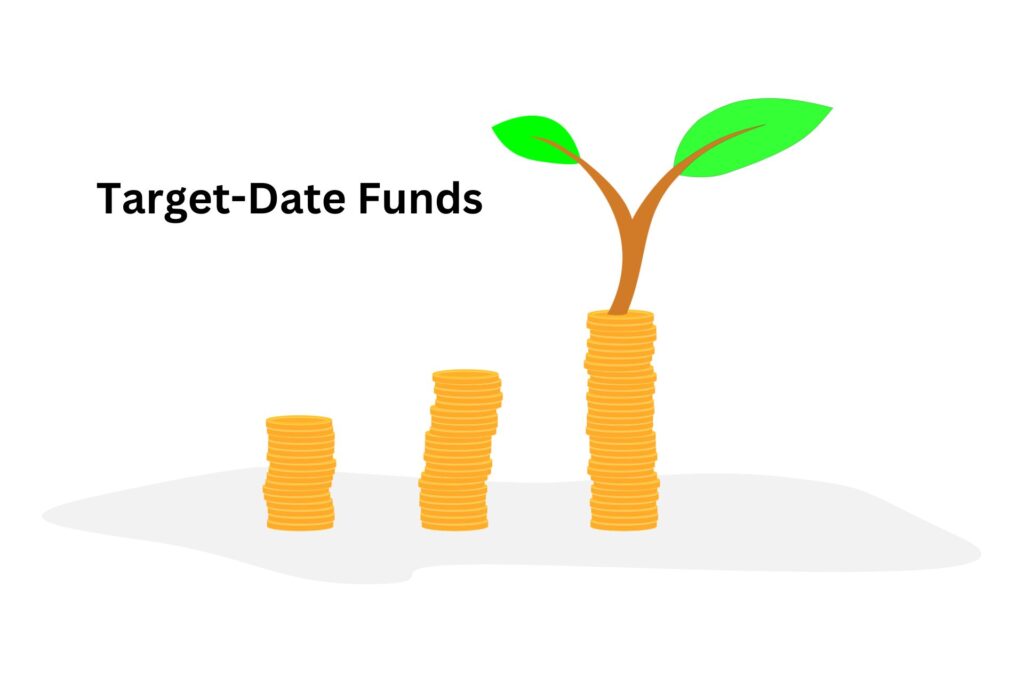If you’re considering investing for retirement or any other long-term goal, you may have come across target-date mutual funds. These funds are a popular investment option for people who want a simple, diversified portfolio that automatically adjusts over time. In this article, we’ll discuss what a target-date fund is, how it works, its advantages and disadvantages, and how to invest in one.
How to Invest in Target Date Funds?
Investing in a target-date fund is easy. You can invest through a retirement plan or brokerage account. Follow these steps:
Step 1: Determine your investment goals and risk tolerance
Before investing in a target-date fund, you should know your investment goals and risk tolerance. It’ll help you choose the appropriate fund with a target date that matches your investment horizon.
Step 2: Choose a target-date fund
After determining your investment goals and risk tolerance, the next step is to choose a target-date fund. You can research and compare different target-date funds to find one that suits your needs.
Step 3: Open an account
Once you have selected a target-date fund, the next step is to open an account with the fund provider. It can be done online or by filling out an application form.
Step 4: Determine your contribution amount
After opening an account, you must determine how much money you want to contribute to the fund. You can do this through a lump-sum investment or regular contributions.
Step 5: Set up automatic contributions
To make investing more convenient, you can set up automatic contributions. It’ll ensure that a fixed amount is invested in the fund regularly.
Step 6: Monitor your investment
While target-date funds are designed to be a set-and-forget investment, monitoring your investment is still important. You should review your investment at least once a year to ensure it aligns with your investment goals and risk tolerance.
Why Should I Invest in a Target Date Fund?
One of the main reasons you should invest in this fund is its simplicity. A target-date approach is a single investment that automatically adjusts its asset allocation over time based on your target retirement date. It means you don’t have to worry about rebalancing your portfolio or adjusting your investments as you get closer to retirement.
Another reason is diversification. These funds invest in a mix of stocks, bonds, and other assets to provide a balanced portfolio. As you get closer to retirement, the fund automatically shifts its allocation to more conservative investments, reducing the risk of losing money.
How Do Target Date Funds Work?
These funds use a traditional portfolio management method to meet its investment return objectives. When you invest in a target-date fund, you choose the fund with a target retirement date closest to the year you plan to retire.
The fund starts with a higher allocation of stocks and other riskier investments, which generate higher returns but also come with higher risk. High-risk portfolio investments include domestic and global equities.
As you get closer to retirement, the fund shows the glide path and form glide rate. Then the target date portfolio automatically allocates to more conservative investments, such as bonds and cash, to protect your portfolio from market downturns.
Some target-date funds (through funds) will continue to manage funds to a specified asset allocation past the target date, focusing more on low-risk, fixed-income investments. Other target-date funds (to funds) will stop modifying asset allocation once the target date is reached.
Examples of Target Date Funds
A good example is the Vanguard Target Retirement 2025 Fund (VTTVX). This fund is designed for investors planning to retire around 2025. The fund’s asset allocation starts with a higher percentage of stocks and gradually shifts to more bonds and cash as the target retirement date approaches.
Vanguard 2065 (VLXVX) Fund vs. Vanguard 2025 Fund (VTTVX)
The Vanguard Target Retirement 2065 Fund (VLXVX) and the Vanguard Target Retirement 2025 Fund (VTTVX) differ in expense ratios, portfolio allocation, and asset weightings.
The expense ratio for the 2065 fund is 0.42%, while that of the 2025 fund is 0.44%.
As of 03/31/2023, the 2065 fund’s portfolio was 89.32% in stocks, 9.25% in bonds, and 1.43% in short-term reserves. While Vanguard Total Stock Market Index Fund Institutional Plus Shares allocates most assets.
As of 03/31/2023, the 2025 fund’s portfolio, was 55% in stocks, 44.02% in bonds, and 0.98% in short-term reserves.
While both funds invest in the same assets, the 2065 fund is more heavily weighted toward stocks, making it more suitable for investors with a longer investment horizon.
In contrast, the 2025 fund has greater weight in fixed income and fewer stocks, making it less volatile and more likely to contain the assets investors need to begin making withdrawals in 2025.
What Is The Average Return on Target Date Funds?
The average return on these funds varies depending on the fund’s investment strategy and market conditions. The average return of a target-date fund is usually calculated as the average of its annual returns over a specified period.
Note that the average return is not a reliable predictor of future returns. Investors should focus on long-term investment goals and risk tolerance rather than short-term market performance.
Pros and Cons of Target Date Funds
Pros
- Diversification: They offer instant diversification by investing in a mix of stocks, bonds, and other assets.
- Simplification: These funds are designed to be simple and easy to use, with a set asset allocation that automatically adjusts over time.
- Professional management: They are managed by professionals who make investment decisions on your behalf, so you don’t need to worry about picking individual stocks or bonds.
- Reduced risk: These funds adjust the asset allocation as you get closer to retirement, which reduces the risk of losing money in a market downturn.
- Flexibility: They are also available in various options to suit risk tolerances and retirement timelines.
Cons
- Lack of control: Target-date funds are managed by professionals, which means you have less control over investment decisions.
- Limited customization: Target-date funds offer a set asset allocation that may not suit your specific investment goals or risk tolerance.
- Fees: Target-date funds come with management fees, which can eat into your returns over time.
- Lack of transparency: Target-date funds may not disclose all underlying investments, making it difficult to understand where your money is being invested.
- No guarantees: While target-date funds are designed to reduce risk, there is no guarantee that you won’t lose money, especially during a market downturn.
Bottom Line
Target-date funds are investment vehicles designed to simplify retirement planning by automatically adjusting asset allocation as the investor approaches their retirement date. These funds are available at various levels of risk and return, allowing investors to choose the one that best suits their investment goals and risk tolerance.
While target-date funds are not without drawbacks, such as limited customization and higher fees, they remain a popular option for retirement investing due to their simplicity and ease of use. As with any investment decision, it is important for investors to consider their options and consult with a financial advisor before making any investment

